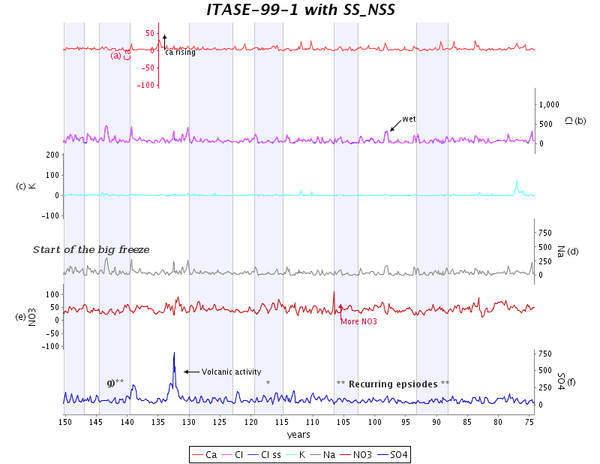
|
Our early work on p301 has resulted in a data explorer application, p301dx, that is designed to help scientists study large and often disparate datasets. Currently, the application allows scientists to explore various collections of climate and ice-core datasets. The tool is highly responsive and allows users to re-sample and display large datasets very quickly. The graphs that are created can then be exported as high-quality vector images in SVG, EPS, and PDF formats, as well as bitmapped images in PNG format.
A screenshot of a typical p301dx session appears as Figure 1. The chart in this session has been built by processing and plotting data from the Siple Dome core, with additional markers corresponding to notable dates extracted from the PDF version of a research paper [2]. When one of these markers is selected, the relevant text from the paper is displayed.
Interface As suggested by Figure 1, the graphical interface is composed of five panels. The largest panel displays the charts and other graphical products resulting from data manipulation operations. The two small panels above the chart panel are used by the system to provide feedback and to solicit input. The two panels on the left are the most interesting ones. The upper one is a dynamic palette of functional tools: Each tool is a function that takes one or more objects as arguments and produces one or more objects as output. Input data objects are drawn from the working objects panel in the bottom right corner, and the resulting data objects are deposited there as well. Many tools, such as those that expand objects or smooth time-series data, take one or more data objects as their functional arguments. However, tools are also permitted to use other tools as arguments. As a simpleexample, a composition tool takes two tools, T1 and T2 as arguments and produces a new tool, T3, the composition of T1 and T2, that is deposited in the tool palette.
Charts An important feature of p301dx is its ability to produce the kind of detailed, carefully formatted and annotated charts customarily used in climate-change research. To this end, the system provides the expected interactive tools for manipulating chart components such as markers, labels, scales, and colors. Further, all charts can be exported in both vector and raster formats, to enable easy processing by other tools. Figure 2 depicts a simple example of such a chart, the unedited output of p301dx.

|
Additional examples and screenshots appear in the next section.